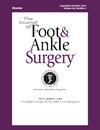Impact of glucagon-like peptide-1 receptor agonists on postoperative outcomes following ankle fracture open reduction and internal fixation
IF 1.3
4区 医学
Q2 Medicine
引用次数: 0
Abstract
Glucagon-like peptide-1 receptor agonists (GLP-1RA) are quickly growing in popularity as effective tools in the management of diabetes and weight loss. Despite this increased usage, there is a paucity of literature investigating the use of GLP-1RA in patients with ankle fractures. This study aims to compare the outcomes of patients undergoing ankle fracture open reduction and internal fixation (ORIF) receiving therapy with GLP-1RA to those not receiving treatment. A retrospective analysis was performed utilizing the TriNetX research network to query patients who underwent ankle fracture ORIF between 2000–2024. Two cohorts were established according to preoperative GLP-1RA usage with 1:1 matching by propensity scores for demographics and comorbidities. Primary outcomes included the risk of postoperative complications (i.e. infection, sepsis, wound dehiscence, cellulitis, thrombosis, nonunion, reoperation, revision, etc.) at 30-days, 90-days, 1-year, and 5-years. There were 123,546 patients not taking GLP-1RA and 1,173 patients taking GLP-1RA who underwent ORIF for an ankle fracture, with propensity score matching resulting in two cohorts of 1,173 patients each. After matching, there were no significant differences in demographics or comorbidities, including a 75.6 % prevalence of diabetes mellitus and 68.7 % prevalence of overweight or obesity in both cohorts. At 30-days postoperatively, the no GLP-1RA cohort had a significantly higher rate of removal of hardware (Odds Ratio [OR] 1.953, 95 % Confidence Interval (CI) 1.062-3.591); no other complications demonstrated significant differences at 30-days, 90-days, 1-year, or 5-years postoperatively. These findings further underscore the low risk of preoperative GLP-1RA usage noted in other orthopaedic procedures.
胰高血糖素样肽-1受体激动剂对踝关节骨折切开复位内固定术后疗效的影响。
胰高血糖素样肽-1受体激动剂(GLP-1RA)作为治疗糖尿病和减肥的有效工具而迅速普及。尽管GLP-1RA的使用越来越多,但研究GLP-1RA在踝关节骨折患者中的应用的文献却很少。本研究旨在比较接受GLP-1RA治疗的踝关节骨折切开复位内固定(ORIF)患者与未接受GLP-1RA治疗的患者的预后。利用TriNetX研究网络对2000-2024年间接受踝关节骨折ORIF的患者进行回顾性分析。根据术前GLP-1RA使用情况建立两个队列,人口统计学和合并症倾向评分1:1匹配。主要结局包括30天、90天、1年和5年的术后并发症风险(感染、败血症、伤口裂开、蜂窝织炎、血栓形成、不愈合、再手术、翻修等)。有123,546名患者未服用GLP-1RA, 1173名患者服用GLP-1RA,接受ORIF治疗踝关节骨折,倾向评分匹配导致两个队列各1173名患者。匹配后,在人口统计学或合并症方面没有显著差异,包括两个队列中糖尿病患病率为75.6%,超重或肥胖患病率为68.7%。术后30天,无GLP-1RA组的硬体取出率显著高于对照组(优势比[OR] 1.953, 95%可信区间(CI) 1.062-3.591);在术后30天、90天、1年或5年无其他并发症表现出显著差异。这些发现进一步强调了其他骨科手术中术前使用GLP-1RA的低风险。证据等级:3级,回顾性队列研究。
本文章由计算机程序翻译,如有差异,请以英文原文为准。
求助全文
约1分钟内获得全文
求助全文
来源期刊

Journal of Foot & Ankle Surgery
ORTHOPEDICS-SURGERY
CiteScore
2.30
自引率
7.70%
发文量
234
审稿时长
29.8 weeks
期刊介绍:
The Journal of Foot & Ankle Surgery is the leading source for original, clinically-focused articles on the surgical and medical management of the foot and ankle. Each bi-monthly, peer-reviewed issue addresses relevant topics to the profession, such as: adult reconstruction of the forefoot; adult reconstruction of the hindfoot and ankle; diabetes; medicine/rheumatology; pediatrics; research; sports medicine; trauma; and tumors.
 求助内容:
求助内容: 应助结果提醒方式:
应助结果提醒方式:


